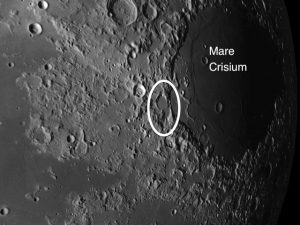The week of June 17-23 takes us from Day 15, full moon, to the end of Day 20. This week we will highlight an object informally referred to as “O’Neill’s Bridge,” viewable early Wednesday morning around 1:00 a.m.
 O’Neill’s Bridge: [NE/H15] There is a fascinating lesson here about how even trained scientists can allow their imaginations to run away with them. In 1953 amateur astronomer John O’Neill, using a 4″ refractor, reported having discovered a man-made bridge near the western shore of Mare Crisium. The bridge “had the amazing span of about 12 miles from pediment to pediment.” (The two “pediments” were the tip ends of Promentorium Lavinium and Promentorium Olivium.)1 O’Neill called for verification from professionals, and British astronomer Hugh Percy Wilkins corroborated that there was, indeed, such a bridge. American astronomers disputed the claim, saying that it was an illusion. But before the matter was settled, the news media, without bothering to check the facts (some things never change) prematurely announced the discovery of an artificial bridge on the Moon. (Not coincidentally, the 1950s were the peak of the “flying saucer” rage, so the public was ripe!) Wilkins was blamed for the resulting media circus and was forced to resign from the British Astronomical Association.
O’Neill’s Bridge: [NE/H15] There is a fascinating lesson here about how even trained scientists can allow their imaginations to run away with them. In 1953 amateur astronomer John O’Neill, using a 4″ refractor, reported having discovered a man-made bridge near the western shore of Mare Crisium. The bridge “had the amazing span of about 12 miles from pediment to pediment.” (The two “pediments” were the tip ends of Promentorium Lavinium and Promentorium Olivium.)1 O’Neill called for verification from professionals, and British astronomer Hugh Percy Wilkins corroborated that there was, indeed, such a bridge. American astronomers disputed the claim, saying that it was an illusion. But before the matter was settled, the news media, without bothering to check the facts (some things never change) prematurely announced the discovery of an artificial bridge on the Moon. (Not coincidentally, the 1950s were the peak of the “flying saucer” rage, so the public was ripe!) Wilkins was blamed for the resulting media circus and was forced to resign from the British Astronomical Association.
Now put yourself to the test: Tonight near the southwest shore of Mare Crisium you will find the ghost crater Yerkes. Immediately west of Yerkes are two promontories forming the shoreline of Crisium. When the Sun is at the right angle, the lighting will create the illusion of a bridge spanning the two promontories. Could you be convinced, in a more gullible climate, that you were staring at a man-made bridge? (Although the original sighting was made with a 4″ refractor, it was corroborated by Wilkins who was using a 15” Newtonian at 300x.) The best time to view the bridge is around Day 17 (Wednesday night) when the two promontories are just lit up by the setting Sun. If you don’t see it Wednesday night, come back later and keep trying. The lighting has to be pre3tty spot-on.
OF ADDITIONAL INTEREST IN SPACE THE WEEK OF JUNE 17:
Great news for people who love to travel! NASA is planning to allow civilians to take sight-seeing trips into space, and this could happen as early as 2020. The cost for the flight will be a mere $50 million. The price of the accommodations on the Space Station (not included in the cost of the flight) is $35,000 per night for 30 nights, so if you’ve got a spare $51 million lying around, go for it!
The Summer Solstice (from Latin solstitium “sun standing”) will occur this Friday on June 21st. This is the beginning of summer, and is a time when the Sun reaches its northernmost point in the sky, stops moving, then reverses its direction towards the south.
1 These two promontories are not listed on the Field Map, but they are located on the WSW shore of Crisium.
======================
It is highly recommended that you get a copy of Sky and Telescope’s Field Map of the Moon, the very finest Moon map available for use at the telescope. It is available for $10.95 at www.skyandtelescope.com and on Amazon. All features mentioned in this blog will be keyed to the grid on the Field Map and will look like this: Plato: [NW/D9]
Credits:
Courtesy of Gray Photography of Corpus Christi, Texas
Lunar photos: NASA / USGS / BMDO / LROC / ASU / DLR / LOLA / Moon Globe. Used by permission
- Rupes Cauchy: A Best Known Fault on the Moon - July 22, 2024
- Moon Crater Schickard – Crater Floor has Stripes - July 15, 2024
- Moon Craters Langrenus and Vandelinus - July 8, 2024